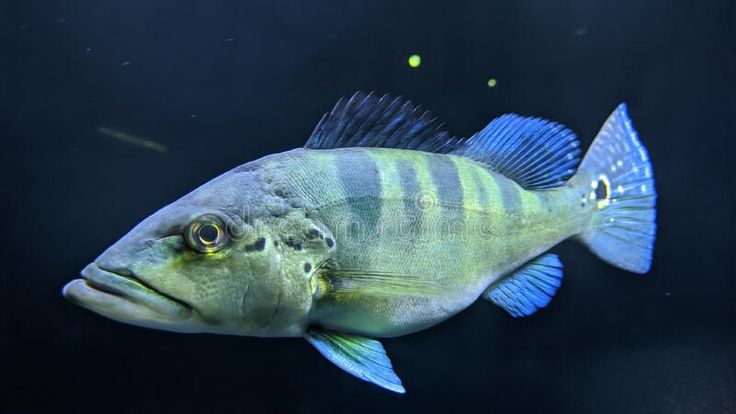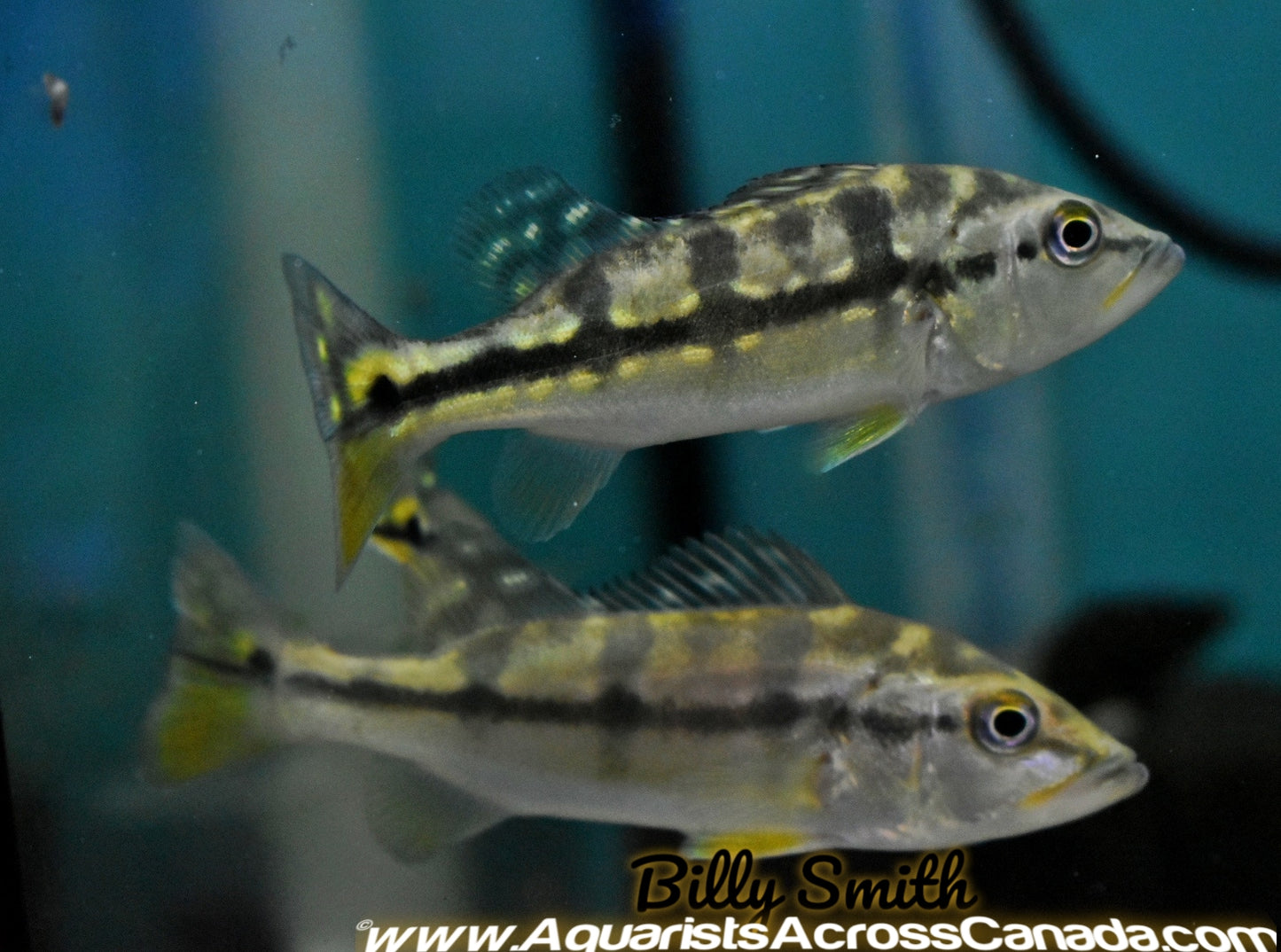SKU:CSA1728S
PEACOCK BASS *AZUL* (Cichla Piquiti) 2.5"
PEACOCK BASS *AZUL* (Cichla Piquiti) 2.5"
Out of stock
Couldn't load pickup availability
Azul Peacock Bass (Cichla piquiti) are native to the rivers and tributaries of northern South America in Colombia, Venezuela, Guianas & Brazil. They have also been introduced to areas outside of their native habitat including: Florida, Hawaii, Puerto Rico and Singapore. Key characteristics to look for to positively ID Cichla piquiti include: grayish brown body color, bluish coloration on fins, vertical dark bars throughout the length of the body and yellow dots along with a eye-spot on their tail fin. Cichla piquiti are very fast growers, who will grow quickly to about 16 to 18 inches in length and then over time depending on food source, water condition and tank size, reach an eventual adult length of upwards of 29 inches. They are a very fast swimming and boisterous species that will hit prey items (even pellet foods) with amazing force that can startle other tank mates and their human owners alike.
Despite the aggression they show towards their prey, they are not considered to be that aggressive towards other suitably sized tank mates. The reason size is so critical is that tank mates that are not at least half as large as the Azul Peacock Bass will usually be reguarded as prey. So despite not being too aggressive towards tank mates, their shear size and fast, burst ambush style feeding behavior make Azul Peacocks a poor choice to keep with timid fish species, who may find aquarium life with an Azul difficult.
Azul Peacock Bass are ambush hunters who navigate their native river and tributary waters in search of prey both above and below the waters surface. Their native waters are very warm year round with temperatures reaching upwards of 86° when the sun is at its peak, and with nighttime temperatures still hovering around the 76° to 80° mark. The water conditions of their natural habitat are acidic with a pH range of 5.0 to 6.5 and a water hardness between 5 to 15 dH; as well as, moderate flow and a large volume of water passing down river daily. Cichla have evolved perfectly for their environment with color patterns enabling them to blend into their environment, long sleek bodies and powerful pectoral and anal fins, which they use to maintain ambush positions in flowing river waters and ambush prey.
Azul Peacock Bass are available within the aquarium hobby despite the Brazilian government banning their export from many locations; however, their size, pattern, coloration and aggressive feeding habits have made them highly sought after with aquarium hobbyists interested in keeping larger New World Cichlid species. As the popularity of Peacock Bass in general has grown within the aquarium hobby, breeders have been busy with propagating Cichla to fill the demand. Unfortunately most breeders do not attempt to maintain the pureness of each species and instead cross breed multiple species of Peacock Bass which has led to an abundance of hybrids being sold to aquarium hobbyists.
Aquarium Care
When keeping Azul Peacock Bass in an aquarium environment, it is important to account for their large size, feeding habits and aggressive nature. Azul Peacock Bass come from river ways that have a constant flow of fresh water which keeps oxygen levels high and nutrient levels low. Peacock Bass have become accustomed to an environment with high quality water with low levels of pollutants and high levels of oxygen. Peacock Bass aquariums need to replicate this environment through strong mechanical, chemical and biological filtration along with medium water movement. Peacock Bass are large fish that eat equally large meals, thus excellent filtration is required to remove the excess food and waste products produced from such a large species. The adult size of the Azul Peacock Bass is also an important factor in choosing the right aquarium to house them, with the size and shape of the aquarium being very important.
Adult sizes range from around 26 to 28 inches in length, thus it is important to provide an aquarium that is long enough and wide enough from front to back to allow the Peacock Bass to swim and turn around comfortably. An aquarium of 6 to 8 feet in length and 3 feet from front to back should be considered as minimum aquarium size for an adult specimen, while smaller specimens can be raised in smaller aquariums if they are moved to larger tanks as they grow. The aquarium decor should be designed to provide plenty of swimming room, while also providing some areas of cover using driftwood, floating or well rooted plants and rocks with a sandy or gravel substrate.
Tank mates are an important consideration when housing adult Peacock Bass with other New World Cichlids due to their large size and aggressive temperament. A good rule of thumb is that anything that can fit in the mouth of the Peacock Bass eventually will. Tank mates should consist of other large aggressive New World Cichlids, large Catfish species and freshwater rays. Safe tank mates should be roughly at least half the size of the Azul Peacock Bass to be sure that they will not be seen as a food source. Azul Peacock Bass can be kept as the only Peacock Bass species or mixed with other species of Peacock Bass. When kept in a suitably large aquarium, they will do well in good sized groups and will work out a dominance structure among themselves, which will lower aggression between fish once their social hierarchy is in place.
Feeding & Nutrition
Wild Peacock Bass feed on a wide variety of live foods living in their river ecosystem, which include: insects, smaller fish, worms, crustaceans and amphibians. Azul Peacock Bass kept within the aquarium environment will readily feed on the same variety of live foods that they feed on in nature, but it is often more desirable to ween them off of live foods. Live foods are typically more expensive, require holding facilities, more frequent trips to the aquarium store, can bring diseases and can create excess pollution in the aquarium water. Hobbyists generally ween their Peacock Bass to commercial food preparations in order to simplify their care and avoid the pitfalls or live foods. However, it is not uncommon for Peacock Bass enthusiasts who have weened their fish to commercial foods to provide the occasional live feeding to enjoy the prey drive and aggressive feeding technique of the Peacock Bass. Suitable commercial foods for Peacock Bass include: blood worms, pellet foods, food sticks, frozen meaty foods like krill, silver sides or similar fare. Peacock Bass will also consume a variety of dead meaty foods like raw shrimp, raw fish and other meaty items. Individual specimens will often have their own preferences, with some specimens eating most anything while others will be more picky about their diet.
Share




